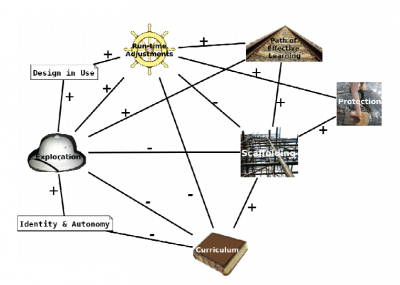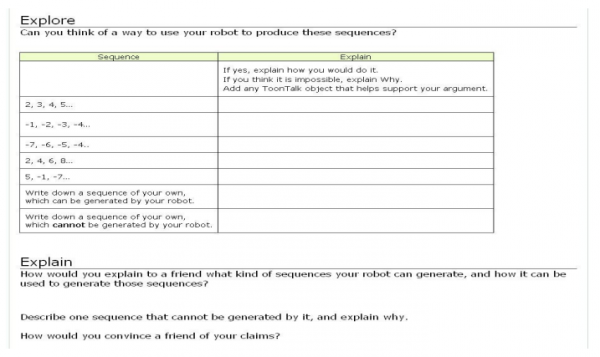Soft Scaffolding/OG
| Soft Scaffolding | |
| Contributors | Yishay Mor |
|---|---|
| Last modification | May 16, 2017 |
| Source | Mor (2008)[1] |
| Pattern formats | OPR Alexandrian |
| Usability | |
| Learning domain | |
| Stakeholders | |
Technology should be designed to scaffold learners' progress, but an interface that is too rigid impedes individual expression, exploration and innovation.
The problem
Scaffolding is a powerful tool for accelerating learning. It is a fundamental principle in many interactive learning environments, such as OISE's Knowledge Forum, and is a guiding principle in Learner-centred approaches (c.f. Quintana et al.[2]). However, scaffolds can become straitjackets when they are too imperative.
How do you provide direction and support while maintaining the learners’ freedom, autonomy and sense of self, as well as the teachers’ flexibility to adapt?
Forces
• The role of the educator, and by extension educational tools, is to direct the learner towards a productive path or enquiry.
• If the educational tool adamantly leads the learner through a set sequence, it risks failure on several accounts:
-There is no leeway for mistakes, innovations, explorations or personal trajectories of learning.
-Learners feel deprived of personal voice, and their motivation may falter.
-It is hard to bypass design flaws discovered in the field or adjust to changing circumstances.
Context
Scaffolding is a term commonly used in educational design to describe structure that directs the learner's experience along an effective path of learning. This pattern originates from interactive web based interfaces, where users can express themselves in writing. However, it should apply to almost any interactive learning interface.
Solution
Provide scaffolding which can easily be overridden by the learner or by the instructor. Let the scaffolding be a guideline, a recommendation which is easier to follow than not, but leave the choice in the hands of the learner.
• When providing a multiple-selection interface, always include an open choice, which the user can specify (select 'other' and fill in text box).
• When the user is about to stray off the desired path of activity, warn her, ask for confirmation, but do not block her.
• When providing templates for user contributions, include headings and tips but allow the user to override them with her own structure.
Examples
The Active Worksheet (Active Worksheet) used in the WebReports system[3] provided participants a structure to work within, but allowed them to take control and change this structure as their confidence grew (Figure 2).
The ToonTalk tool packaging convention[4], which was the basis for Task In A Box (Task In A Box), prompted learners to package their own productions in a particular way by providing them with useful examples. It did not block them from developing their own packaging style, but the ToonTalk-weblabs interface did give precedence to conventionally packaged constructions (Figure 3).
Related Patterns
Used by: Guess My X (Guess My X); Weblabs Pedagogical Cycle (Weblabs Pedagogical Cycle); Narrative Spaces (Narrative Spaces)
Elaborated by: Active Worksheet (Active Worksheet)
Notes
The forces of this pattern are present in face-to-face learning situations. Experienced educators resolve them by providing Adaptive Support (Adaptive Support); varying the learners freedom in response to their confidence. This could be implemented by intelligent tutoring systems, but simple learning environments lack this flexibility, and tend to compensate by being over-directive.
References
- ↑ Mor, Y. (2008). Guess my X and other Techno-pedagogical Patterns: Toward a Language of Patterns for Teaching and Learning Mathematics. In Proceedings of the 13th European Conference on Pattern Languages of Programs (EuroPLoP 2008). New York:ACM.
- ↑ Quintana, C., Soloway, E., & Norris, C. (2001). Learner-centered design: developing software that scaffolds learning. In Advanced Learning Technologies, Proceedings IEEE International Conference (pp. 499-500). IEEE.
- ↑ Mor, unpublished.
- ↑ Mor, Y., Noss, R., Hoyles, C., Kahn, K., & Simpson, G. (2006). Designing to see and share structure in number sequences. International Journal for Technology in Mathematics Education, 13(2), 65-78.



